Recent Advancements in Metal–Organic Framework-Based Microfluidic Chips for Biomedical Applications
Abstract
1. Introduction
2. Biomedical Applications of MOFs: From Material Innovations to Microfluidic Devices
2.1. Drug Delivery and Controlled Release
2.2. Biosensing and Molecular Recognition
2.2.1. Signal Amplification
2.2.2. On-Chip Bacterial/Viral Detection
2.3. Bioimaging Enhancement
2.4. Antibacterial and Antiviral Activity
Pathogen Detection and Antimicrobial Surfaces
3. Microfluidic Platforms in Biomedicine
3.1. Diagnostic and Therapeutic Platforms
3.1.1. Organ-on-a-Chip
3.1.2. Key Performance Metrics
3.2. Types of Microfluidic Chips
3.2.1. Paper-Based
3.2.2. Polymer-Based
3.2.3. Glass-Based Microfluidic Chips
4. Strategies for Integrating MOFs into Microfluidic Platforms
4.1. Fabrication Techniques
4.1.1. In Situ Growth
4.1.2. Layer-by-Layer (LBL) Assembly
4.1.3. Immobilization
4.1.4. Encapsulation in Polymers
4.1.5. 3D Printing Approaches
4.1.6. Hybrid Systems
4.2. Compatibility with Chip Materials and Fabrication Constraints
5. Challenges and Future Directions
5.1. Limitations of MOF-Based Microfluidic Chips in Biomedical Applications
5.2. Future Directions and Opportunities
5.2.1. Smart and Stimuli-Responsive MOFs
5.2.2. AI-Assisted MOF Sensor Design
5.2.3. MOF-Based Microfluidic Hybrids Manufactured Through 3D Printing
6. Conclusions and Outlooks
Author Contributions
Funding
Conflicts of Interest
Abbreviations
| MOF | Metal–organic framework |
| COFs | covalent organic frameworks |
| ZIF8 | Zeolitic Imidazolate Framework-8 |
| MIL-88A | Materials of Institute Lavoisier-88A |
| UiO-66(Zr) | University of Oslo-66 (Zirconium) |
| LOD | limit of detection |
| GOx | glucose oxidase |
| HRP | horseradish peroxidase |
| PDA | polydopamine |
| PEI | polyethyleneimine |
| GCE | glassy carbon electrode |
| CA15-3 | tumor marker |
| DPV | differential pulse voltammetry |
| nano-Yb-PVDC-3 | nano-Yb-phenylenevinylenedicarboxylate-3 |
| NIR | near-infrared |
| FeTPt | MOF incorporated meso-tetra(4-carboxyphenyl)porphine |
| CCM | cancer cell membrane |
| IVIS | in vivo imaging system |
| ICG | indocyanine green |
| BDC | benzene 1,4-dicarboxylic acid |
| aPDT | antimicrobial photodynamic therapy |
| RB | Rose Bengal |
| CTC | circulating tumor cells |
| FRET | fluorescent resonance energy transfer) |
| NporMOF(Fe) | nano-metalloporphyrinic |
| NO | nitic oxide |
| H2O2 | hydrogen peroxide |
| BOC | bone-on-a-chip |
| POCT | point-of-care testing |
| LBL | layer-by-layer |
| PICs | photonic integrated circuits |
| BSA | bovine serum albumin |
| TA | tannic acid |
| MRRs | micro-ring resonators |
| MZIs | Mach–Zehnder interferometers |
| LPE | liquid-phase epitaxy |
| BDC-NH2 | 2-aminoterephthalic acid |
| MEAs | metal microelectrode arrays |
| HOFs | hydrogen-bonded organic frameworks |
| AuNPs | gold nanoparticles |
| VOCs | volatile organic compound |
| CbAgo | clostridium butyricum argonaute |
| PDMS | polydimethylsiloxane |
| L-Trp | L-tryptophan |
| TAC | total antioxidant capacity |
| TMB | 3,3′,5,5′-Tetramethylbenzidine |
| VSA | virtual sensor array |
| QCM | quartz crystal microbalance |
References
- Gharib, G.; Bütün, İ.; Muganlı, Z.; Kozalak, G.; Namlı, İ.; Sarraf, S.S.; Ahmadi, V.E.; Toyran, E.; van Wijnen, A.J.; Koşar, A. Biomedical Applications of Microfluidic Devices: A Review. Biosensors 2022, 12, 1023. [Google Scholar] [CrossRef] [PubMed]
- Al-Ali, A.; Waheed, W.; Abu-Nada, E.; Alazzam, A. A review of active and passive hybrid systems based on Dielectrophoresis for the manipulation of microparticles. J. Chromatogr. A 2022, 1676, 463268. [Google Scholar] [CrossRef] [PubMed]
- Perez-Gonzalez, V.H. Particle trapping in electrically driven insulator-based microfluidics: Dielectrophoresis and induced-charge electrokinetics. Electrophoresis 2021, 42, 2445–2464. [Google Scholar] [CrossRef]
- Lei, K.F. Microfluidic systems for diagnostic applications: A review. J. Lab. Autom. 2012, 17, 330–347. [Google Scholar] [CrossRef]
- Iyer, V.; Yang, Z.; Ko, J.; Weissleder, R.; Issadore, D. Advancing microfluidic diagnostic chips into clinical use: A review of current challenges and opportunities. Lab Chip 2022, 22, 3110–3121. [Google Scholar] [CrossRef]
- Deliorman, M.; Ali, D.S.; Qasaimeh, M.A. Next-Generation Microfluidics for Biomedical Research and Healthcare Applications. Biomed. Eng. Comput. Biol. 2023, 14, 11795972231214387. [Google Scholar] [CrossRef] [PubMed]
- Ai, Z.; Jiao, L.; Wang, J.; Jiang, H.L. Generation of Hierarchical Pores in Metal–Organic Frameworks by Introducing Rigid Modulator. CCS Chem. 2022, 4, 3705–3714. [Google Scholar] [CrossRef]
- Yaghi, O.M.; O’Keeffe, M.; Ockwig, N.W.; Chae, H.K.; Eddaoudi, M.; Kim, J. Reticular synthesis and the design of new materials. Nature 2003, 423, 705–714. [Google Scholar] [CrossRef]
- Zheng, L.; Wang, F.; Jiang, C.; Ye, S.; Tong, J.; Dramou, P.; He, H. Recent progress in the construction and applications of metal-organic frameworks and covalent-organic frameworks-based nanozymes. Coord. Chem. Rev. 2022, 471, 214760. [Google Scholar] [CrossRef]
- Hu, C.; Bai, Y.; Hou, M.; Wang, Y.; Wang, L.; Cao, X.; Chan, C.W.; Sun, H.; Li, W.; Ge, J.; et al. Defect-induced activity enhancement of enzyme-encapsulated metal-organic frameworks revealed in microfluidic gradient mixing synthesis. Sci. Adv. 2020, 6, eaax5785. [Google Scholar] [CrossRef]
- Hefayathullah, M.; Singh, S.; Ganesan, V.; Maduraiveeran, G. Metal-organic frameworks for biomedical applications: A review. Adv. Colloid Interface Sci. 2024, 331, 103210. [Google Scholar] [CrossRef] [PubMed]
- Dehnoei, M.; Ahmadi-Sangachin, E.; Hosseini, M. Colorimetric and fluorescent dual-biosensor based on zirconium and preasodium metal-organic framework (zr/pr MOF) for miRNA-191 detection. Heliyon 2024, 10, e27757. [Google Scholar] [CrossRef] [PubMed]
- Miller, S.E.; Teplensky, M.H.; Moghadam, P.Z.; Fairen-Jimenez, D. Metal-organic frameworks as biosensors for luminescence-based detection and imaging. Interface Focus 2016, 6, 20160027. [Google Scholar] [CrossRef]
- Khafaga, D.S.R.; El-Morsy, M.T.; Faried, H.; Diab, A.H.; Shehab, S.; Saleh, A.M.; Ali, G.A.M. Metal-organic frameworks in drug delivery: Engineering versatile platforms for therapeutic applications. RSC Adv. 2024, 14, 30201–30229. [Google Scholar] [CrossRef] [PubMed]
- Crivello, C.; Sevim, S.; Graniel, O.; Franco, C.; Pane, S.; Puigmarti-Luis, J.; Munoz-Rojas, D. Advanced technologies for the fabrication of MOF thin films. Mater. Horiz. 2021, 8, 168–178. [Google Scholar] [CrossRef]
- Liu, Y.; Sun, L.; Zhang, H.; Shang, L.; Zhao, Y. Microfluidics for Drug Development: From Synthesis to Evaluation. Chem. Rev. 2021, 121, 7468–7529. [Google Scholar] [CrossRef]
- Coliaie, P.; Bhawnani, R.R.; Prajapati, A.; Ali, R.; Verma, P.; Giri, G.; Kelkar, M.S.; Korde, A.; Langston, M.; Liu, C.; et al. Patterned microfluidic devices for rapid screening of metal-organic frameworks yield insights into polymorphism and non-monotonic growth. Lab Chip 2022, 22, 211–224. [Google Scholar] [CrossRef]
- Koryakina, I.G.; Bachinin, S.V.; Gerasimova, E.N.; Timofeeva, M.V.; Shipilovskikh, S.A.; Bukatin, A.S.; Sakhatskii, A.; Timin, A.S.; Milichko, V.A.; Zyuzin, M.V. Microfluidic synthesis of metal-organic framework crystals with surface defects for enhanced molecular loading. Chem. Eng. J. 2023, 452, 139450. [Google Scholar] [CrossRef]
- Mhettar, P.; Kale, N.; Pantwalawalkar, J.; Nangare, S.; Jadhav, N. Metal-organic frameworks: Drug delivery applications and future prospects. ADMET DMPK 2024, 12, 27–62. [Google Scholar] [CrossRef]
- Jiang, H.; Staeglich, B.; Knoch, J.; Kumar, S.; Dilbaghi, N.; Deep, A.; Ingebrandt, S.; Pachauri, V. Programming layer-by-layer liquid phase epitaxy in microfluidics for realizing two-dimensional metal-organic framework sensor arrays. Environ. Sci. Nano 2025, 12, 1849–1857. [Google Scholar] [CrossRef]
- Mao, C.; Wang, S.; Li, J.; Feng, Z.; Zhang, T.; Wang, R.; Fan, C.; Jiang, X. Metal-Organic Frameworks in Microfluidics Enable Fast Encapsulation/Extraction of DNA for Automated and Integrated Data Storage. ACS Nano 2023, 17, 2840–2850. [Google Scholar] [CrossRef] [PubMed]
- Pinto, R.V.; Cao, C.C.; Lyu, P.; Dovgaliuk, I.; Shepard, W.; Rivière, E.; Su, C.Y.; Maurin, G.; Antunes, F.; Pires, J.; et al. Ultra-Microporous Fe-MOF with Prolonged NO Delivery in Biological Media for Therapeutic Application. Small 2024, 20, 2405649. [Google Scholar] [CrossRef]
- Sezgin, P.; Gulcay-Ozcan, E.; Vučkovski, M.; Bondžić, A.M.; Erucar, I.; Keskin, S. Biomedical Applications of Metal-Organic Frameworks Revisited. Ind. Eng. Chem. Res. 2025, 64, 1907–1932. [Google Scholar] [CrossRef] [PubMed]
- Tran, V.A.; Lee, S.W. pH-triggered degradation and release of doxorubicin from zeolitic imidazolate framework-8 (ZIF8) decorated with polyacrylic acid. RSC Adv. 2021, 11, 9222–9234. [Google Scholar] [CrossRef]
- de Moura Ferraz, L.R.; Tabosa, A.É.G.A.; da Silva Nascimento, D.D.S.; Ferreira, A.S.; de Albuquerque Wanderley Sales, V.; Silva, J.Y.R.; Júnior, S.A.; Rolim, L.A.; de Souza Pereira, J.J.; Rolim-Neto, P.J. ZIF-8 as a promising drug delivery system for benznidazole: Development, characterization, in vitro dialysis release and cytotoxicity. Sci. Rep. 2020, 10, 16815. [Google Scholar] [CrossRef] [PubMed]
- Horcajada, P.; Gref, R.; Baati, T.; Allan, P.K.; Maurin, G.; Couvreur, P.; Férey, G.; Morris, R.E.; Serre, C. Metal–Organic Frameworks in Biomedicine. Chem. Rev. 2012, 112, 1232–1268. [Google Scholar] [CrossRef]
- Mohammad, M.; Razmjou, A.; Liang, K.; Asadnia, M.; Chen, V. Metal-Organic-Framework-Based Enzymatic Microfluidic Biosensor via Surface Patterning and Biomineralization. ACS Appl. Mater. Interfaces 2019, 11, 1807–1820. [Google Scholar] [CrossRef]
- Karimian, M.; Dashtian, K.; Zare-Dorabei, R. Microfluidic chip and chiroptical gold nanoparticle-based colorimetric sensor for enantioselective detection of L-tryptophan. Talanta 2024, 266, 125138. [Google Scholar] [CrossRef]
- Dezhakam, E.; Vayghan, R.F.; Dehghani, S.; Kafili-Hajlari, T.; Naseri, A.; Dadashpour, M.; Khalilzadeh, B.; Kanberoglu, G.S. Highly efficient electrochemical biosensing platform in breast cancer detection based on MOF-COF@Au core-shell like nanostructure. Sci. Rep. 2024, 14, 29850. [Google Scholar] [CrossRef]
- Elgazar, A.; Sabouni, R.; Ghommem, M.; Majdalawieh, A.F. Novel metal–organic framework biosensing platform for detection of COVID-19 RNA. Sci. Rep. 2024, 14, 25437. [Google Scholar] [CrossRef]
- El Aamri, M.; Yammouri, G.; Mohammadi, H.; Amine, A.; Korri-Youssoufi, H. Electrochemical Biosensors for Detection of MicroRNA as a Cancer Biomarker: Pros and Cons. Biosensors 2020, 10, 186. [Google Scholar] [CrossRef]
- Li, H.; Zhang, Z.; Gan, L.; Fan, D.; Sun, X.; Qian, Z.; Liu, X.; Huang, Y. Signal Amplification-Based Biosensors and Application in RNA Tumor Markers. Sensors 2023, 23, 4237. [Google Scholar] [CrossRef] [PubMed]
- Xing, G.; Shang, Y.; Ai, J.; Lin, H.; Wu, Z.; Zhang, Q.; Lin, J.M.; Pu, Q.; Lin, L. Nanozyme-Mediated Catalytic Signal Amplification for Microfluidic Biosensing of Foodborne Bacteria. Anal. Chem. 2023, 95, 13391–13399. [Google Scholar] [CrossRef] [PubMed]
- Liu, X.; Fang, Y.; Chen, X.; Shi, W.; Wang, X.; He, Z.; Wang, F.; Li, C. Cascaded nanozyme-based high-throughput microfluidic device integrating with glucometer and smartphone for point-of-care pheochromocytoma diagnosis. Biosens. Bioelectron. 2024, 251, 116105. [Google Scholar] [CrossRef]
- Fatah, S.A.; Omer, K.M. Aptamer-Modified MOFs (Aptamer@MOF) for Efficient Detection of Bacterial Pathogens: A Review. ACS Appl. Mater. Interfaces 2025, 17, 11578–11594. [Google Scholar] [CrossRef]
- Lu, Y.; Huang, Z.; Dong, Y.; Yu, D.; Jiang, F.; Han, Y.; Chen, Y. Magnetic Fe3O4@MOF@aptamer-mediated entropy-driven fluorescence biosensor for multiplexed and DNA extraction- and amplification-free detection of pathogenic bacteria. Chem. Eng. J. 2024, 499, 155978. [Google Scholar] [CrossRef]
- Sohrabi, H.; Majidi, M.R.; Nami, F.; Asadpour-Zeynali, K.; Khataee, A.; Mokhtarzadeh, A. A novel engineered label-free Zn-based MOF/CMC/AuNPs electrochemical genosensor for highly sensitive determination of Haemophilus influenzae in human plasma samples. Microchim. Acta 2021, 188, 100. [Google Scholar] [CrossRef]
- Mohandas, A.; Deepthi, S.; Biswas, R.; Jayakumar, R. Chitosan based metallic nanocomposite scaffolds as antimicrobial wound dressings. Bioact. Mater. 2018, 3, 267–277. [Google Scholar] [CrossRef]
- Huang, K.; Liu, W.; Wei, W.; Zhao, Y.; Zhuang, P.; Wang, X.; Wang, Y.; Hu, Y.; Dai, H. Photothermal Hydrogel Encapsulating Intelligently Bacteria-Capturing Bio-MOF for Infectious Wound Healing. ACS Nano 2022, 16, 19491–19508. [Google Scholar] [CrossRef]
- Wang, A.; Walden, M.; Ettlinger, R.; Kiessling, F.; Gassensmith, J.J.; Lammers, T.; Wuttke, S.; Peña, Q. Biomedical Metal–Organic Framework Materials: Perspectives and Challenges. Adv. Funct. Mater. 2023, 34, 2308589. [Google Scholar] [CrossRef]
- Ilacas, G.C.; Basa, A.; Nelms, K.J.; Sosa, J.D.; Liu, Y.; Gomez, F.A. Paper-based microfluidic devices for glucose assays employing a metal-organic framework (MOF). Anal. Chim. Acta 2019, 1055, 74–80. [Google Scholar] [CrossRef] [PubMed]
- Li, Z.; Xue, L.; Yang, J.; Wuttke, S.; He, P.; Lei, C.; Yang, H.; Zhou, L.; Cao, J.; Sinelshchikova, A.; et al. Synthetic Biohybrids of Red Blood Cells and Cascaded-Enzymes@ Metal–Organic Frameworks for Hyperuricemia Treatment. Adv. Sci. 2024, 11, 2305126. [Google Scholar] [CrossRef]
- Keskin, S.; Kizilel, S. Biomedical Applications of Metal Organic Frameworks. Ind. Eng. Chem. Res. 2011, 50, 1799–1812. [Google Scholar] [CrossRef]
- Gutiérrez, M.; Zhang, Y.; Tan, J.C. Confinement of Luminescent Guests in Metal-Organic Frameworks: Understanding Pathways from Synthesis and Multimodal Characterization to Potential Applications of LG@MOF Systems. Chem. Rev. 2022, 122, 10438–10483. [Google Scholar] [CrossRef] [PubMed]
- Shano, L.B.; Karthikeyan, S.; Kennedy, L.J.; Chinnathambi, S.; Pandian, G.N. MOFs for next-generation cancer therapeutics through a biophysical approach—A review. Front. Bioeng. Biotechnol. 2024, 12, 1397804. [Google Scholar] [CrossRef] [PubMed]
- Kaur, H.; Sundriyal, S.; Pachauri, V.; Ingebrandt, S.; Kim, K.H.; Sharma, A.L.; Deep, A. Luminescent metal-organic frameworks and their composites: Potential future materials for organic light emitting displays. Coord. Chem. Rev. 2019, 401, 213077. [Google Scholar] [CrossRef]
- Foucault-Collet, A.; Gogick, K.A.; White, K.A.; Villette, S.; Pallier, A.; Collet, G.; Kieda, C.; Li, T.; Geib, S.J.; Rosi, N.L.; et al. Lanthanide near infrared imaging in living cells with Yb3+ nano metal organic frameworks. Proc. Natl. Acad. Sci. USA 2013, 110, 17199–17204. [Google Scholar] [CrossRef]
- Zhang, Q.; Kuang, G.; Wang, H.; Zhao, Y.; Wei, J.; Shang, L. Multi-Bioinspired MOF Delivery Systems from Microfluidics for Tumor Multimodal Therapy. Adv. Sci. 2023, 10, 2303818. [Google Scholar] [CrossRef] [PubMed]
- Xu, X.; Liu, C.; Wang, S.; Mäkilä, E.; Wang, J.; Koivisto, O.; Zhou, J.; Rosenholm, J.M.; Shu, Y.; Zhang, H. Microfluidic-assisted biomineralization of CRISPR/Cas9 in near-infrared responsive metal-organic frameworks for programmable gene-editing. Nanoscale 2022, 14, 15832–15844. [Google Scholar] [CrossRef]
- Balachandran, Y.L.; Li, X.; Jiang, X. Integrated Microfluidic Synthesis of Aptamer Functionalized Biozeolitic Imidazolate Framework (BioZIF-8) Targeting Lymph Node and Tumor. Nano Lett. 2021, 21, 1335–1344. [Google Scholar] [CrossRef]
- Yang, K.; Ni, M.; Xu, C.; Wang, L.; Han, L.; Lv, S.; Wu, W.; Zheng, D. Microfluidic one-step synthesis of a metal−organic framework for osteoarthritis therapeutic microRNAs delivery. Front. Bioeng. Biotechnol. 2023, 11, 1239364. [Google Scholar] [CrossRef] [PubMed]
- Yan, L.; Gopal, A.; Kashif, S.; Hazelton, P.; Lan, M.; Zhang, W.; Chen, X. Metal organic frameworks for antibacterial applications. Chem. Eng. J. 2022, 435, 134975. [Google Scholar] [CrossRef]
- Chen, G.; Yu, Y.; Wu, X.; Wang, G.; Gu, G.; Wang, F.; Ren, J.; Zhang, H.; Zhao, Y. Microfluidic Electrospray Niacin Metal-Organic Frameworks Encapsulated Microcapsules for Wound Healing. Research 2019, 2019, 6175398. [Google Scholar] [CrossRef] [PubMed]
- Bendre, A.; Hegde, V.; Ajeya, K.V.; Manjunatha, S.T.; Somasekhara, D.; Nadumane, V.K.; Kant, K.; Jung, H.; Hung, W.; Kurkuri, M.D. Microfluidic-Assisted Synthesis of Metal—Organic Framework—Alginate Micro-Particles for Sustained Drug Delivery. Biosensors 2023, 13, 737. [Google Scholar] [CrossRef]
- Uthappa, U.T.; Brahmkhatri, V.; Sriram, G.; Jung, H.Y.; Yu, J.; Kurkuri, N.; Aminabhavi, T.M.; Altalhi, T.; Neelgund, G.M.; Kurkuri, M.D. Nature engineered diatom biosilica as drug delivery systems. J. Control. Release 2018, 281, 70–83. [Google Scholar] [CrossRef]
- Arenas-vivo, A.; Arias, V.C.; Amariei, G.; Rosal, R.; Izquierdo-barba, I.; Hidalgo, T.; Beltr, H.I.; Loera-serna, S.; Horcajada, P. Antiadherent AgBDC metal–organic framework coating for escherichia coli biofilm inhibition. Pharmaceutics 2023, 15, 301. [Google Scholar] [CrossRef]
- Wang, P.; He, B.; Wang, B.; Liu, S.; Ye, Q.; Zhou, F.; Liu, W. MXene/Metal–Organic framework based composite coating with photothermal self-healing performances for antifouling application. Chem. Eng. J. 2023, 474, 145835. [Google Scholar] [CrossRef]
- De, A.; Reddy, Y.N.; Paul, S.; Sharma, V.; Tippavajhala, V.K.; Bhaumik, J. Photosensitizable ZIF-8 BioMOF for Stimuli-Responsive Antimicrobial Phototherapy. Mol. Pharm. 2025, 22, 827–839. [Google Scholar] [CrossRef]
- Nakhlband, A.; Kholafazad-Kordasht, H.; Rahimi, M.; Mokhtarzadeh, A.; Soleymani, J. Applications of magnetic materials in the fabrication of microfluidic-based sensing systems: Recent advances. Microchem. J. 2022, 173, 107042. [Google Scholar] [CrossRef]
- Daniel, F.; Kesterson, D.; Lei, K.; Hord, C.; Patel, A.; Kaffenes, A.; Congivaram, H.; Prakash, S. Application of Microfluidics for Bacterial Identification. Pharmaceuticals 2022, 15, 1531. [Google Scholar] [CrossRef]
- Xing, G.; Zhang, W.; Li, N.; Pu, Q.; Lin, J.M. Recent progress on microfluidic biosensors for rapid detection of pathogenic bacteria. Chin. Chem. Lett. 2022, 33, 1743–1751. [Google Scholar] [CrossRef]
- Abebe, E.; Gugsa, G.; Ahmed, M. Review on Major Food-Borne Zoonotic Bacterial Pathogens. J. Trop. Med. 2020, 2020, 4674235. [Google Scholar] [CrossRef]
- Qi, W.; Zheng, L.; Wang, S.; Huang, F.; Liu, Y.; Jiang, H.; Lin, J. A microfluidic biosensor for rapid and automatic detection of Salmonella using metal-organic framework and Raspberry Pi. Biosens. Bioelectron. 2021, 178, 113020. [Google Scholar] [CrossRef]
- Chen, W.; Peng, X.; Kang, L.; Dong, S.; Zhang, J.; Zhao, Y.; Sun, F. Biosensors with vancomycin and polymetallic metal-organic frameworks for colorimetric-fluorescent dual-mode detection and sterilization of bacteria. J. Hazard. Mater. 2025, 482, 136582. [Google Scholar] [CrossRef]
- Yang, Q.; Yang, X.; Guo, K.; Pan, G.; Du, Q.; Ming, L.; Wang, W. Live bacteria detection with high specificity by utilizing Eu3+@MIL-53 (Al) and bacteriophages-based fluorescence biosensor. Talanta 2025, 293, 128060. [Google Scholar] [CrossRef]
- Wu, W.; Kiat Goh, S.C.; Cai, G.; Feng, S.; Zhang, B. Digital metabolic activity assay enables fast assessment of 2D materials bactericidal efficiency. Anal. Chim. Acta 2024, 1285, 342007. [Google Scholar] [CrossRef]
- Wu, W.; Zhao, Q.; Cai, G.; Zhang, B.; Suo, Y.; Liu, Y.; Jin, W.; Mu, Y. All-In-One Escherichia coli Viability Assay for Multi-dimensional Detection of Uncomplicated Urinary Tract Infections. Anal. Chem. 2022, 94, 17853–17860. [Google Scholar] [CrossRef]
- Wu, W.; Cai, G.; Liu, Y.; Suo, Y.; Zhang, B.; Jin, W.; Yu, Y.; Mu, Y. Direct single-cell antimicrobial susceptibility testing of Escherichia coli in urine using a ready-to-use 3D microwell array chip. Lab Chip 2023, 23, 2399–2410. [Google Scholar] [CrossRef]
- Lambert, M.L.; Suetens, C.; Savey, A.; Palomar, M.; Hiesmayr, M.; Morales, I.; Agodi, A.; Frank, U.; Mertens, K.; Schumacher, M.; et al. Clinical outcomes of health-care-associated infections and antimicrobial resistance in patients admitted to European intensive-care units: A cohort study. Lancet Infect. Dis. 2011, 11, 30–38. [Google Scholar] [CrossRef]
- Liu, X.; Chen, X.; Yin, S.; Liu, Y.; Shi, W.; Wang, F.; Li, C. Dual-modal detection of antimicrobial susceptibility in pathogenic bacteria based on the high-throughput microfluidic platform. Chem. Eng. J. 2024, 499, 156506. [Google Scholar] [CrossRef]
- Radhakrishnan, S.; Mathew, M.; Rout, C.S. Microfluidic sensors based on two-dimensional materials for chemical and biological assessments. Mater. Adv. 2022, 3, 1874–1904. [Google Scholar] [CrossRef]
- Bloom, J.S.; Sathe, L.; Munugala, C.; Jones, E.M.; Gasperini, M.; Lubock, N.B.; Yarza, F.; Thompson, E.M.; Kovary, K.M.; Park, J.; et al. Massively scaled-up testing for SARS-CoV-2 RNA via next-generation sequencing of pooled and barcoded nasal and saliva samples. Nat. Biomed. Eng. 2021, 5, 657–665. [Google Scholar] [CrossRef]
- Chen, J.; Oudeng, G.; Feng, H.; Liu, S.; Li, H.-W.; Ho, Y.-P.; Chen, Y.; Tan, Y.; Yang, M. 2D MOF Nanosensor-Integrated Digital Droplet Microfluidic Flow Cytometry for In Situ Detection of Multiple miRNAs in Single CTC Cells. Small 2022, 18, e2201779. [Google Scholar] [CrossRef]
- Kim, M.K.; Paek, K.; Woo, S.M.; Kim, J.A. Bone-on-a-Chip: Biomimetic Models Based on Microfluidic Technologies for Biomedical Applications. ACS Biomater. Sci. Eng. 2023, 9, 3058–3073. [Google Scholar] [CrossRef]
- Hirama, H.; Satoh, T.; Sugiura, S.; Shin, K.; Onuki-Nagasaki, R.; Kanamori, T.; Inoue, T. Glass-based organ-on-a-chip device for restricting small molecular absorption. J. Biosci. Bioeng. 2019, 127, 641–646. [Google Scholar] [CrossRef]
- Awasthi, G.; Shivgotra, S.; Nikhar, S.; Sundarrajan, S.; Ramakrishna, S.; Kumar, P. Progressive Trends on the Biomedical Applications of Metal Organic Frameworks. Polymers 2022, 14, 4710. [Google Scholar] [CrossRef]
- Imaz, I.; Rubio-Martínez, M.; An, J.; Solé-Font, I.; Rosi, N.L.; Maspoch, D. Metal-biomolecule frameworks (MBioFs). Chem. Commun. 2011, 47, 7287–7302. [Google Scholar] [CrossRef]
- Ecke, A.; Bell, J.; Schneider, R.J. A three-dimensional microfluidic flow cell and system integration for improved electrochemical substrate detection in HRP/TMB-based immunoassays†. Sens. Diagn. 2023, 2, 887–892. [Google Scholar] [CrossRef]
- Gimondi, S.; Ferreira, H.; Reis, R.L.; Neves, N.M. Microfluidic Devices: A Tool for Nanoparticle Synthesis and Performance Evaluation. ACS Nano 2023, 17, 14205–14228. [Google Scholar] [CrossRef]
- Lei, J.; Qian, R.; Ling, P.; Cui, L.; Ju, H. Design and sensing applications of metal-organic framework composites. TrAC Trends Anal. Chem. 2014, 58, 71–78. [Google Scholar] [CrossRef]
- Ling, P.H.; Zang, X.N.; Qian, C.H.; Gao, F. A metal-organic framework with multienzyme activity as a biosensing platform for real-time electrochemical detection of nitric oxide and hydrogen peroxide. Analyst 2021, 146, 2609–2616. [Google Scholar] [CrossRef]
- Tan, A.S.; Nerurkar, S.N.; Tan, W.C.C.; Goh, D.; Lai, C.P.T.; Poh Sheng Yeong, J. The Virological, Immunological, and Imaging Approaches for COVID-19 Diagnosis and Research. SLAS Technol. 2020, 25, 522–544. [Google Scholar] [CrossRef]
- Cui, W.; Ren, Z.; Song, Y.; Ren, C.L. Development and potential for point-of-care heavy metal sensing using microfluidic systems: A brief review. Sens. Actuators A Phys. 2022, 344, 113733. [Google Scholar] [CrossRef]
- Ray, R.; Prabhu, A.; Prasad, D.; Garlapati, V.K.; Aminabhavi, T.M.; Mani, N.K.; Simal-Gandara, J. Paper-based microfluidic devices for food adulterants: Cost-effective technological monitoring systems. Food Chem. 2022, 390, 133173. [Google Scholar] [CrossRef]
- Yuan, M.; Li, C.; Zheng, Y.; Cao, H.; Ye, T.; Wu, X.; Hao, L.; Yin, F.; Yu, J.; Xu, F. A portable multi-channel fluorescent paper-based microfluidic chip based on smartphone imaging for simultaneous detection of four heavy metals. Talanta 2024, 266, 125112. [Google Scholar] [CrossRef]
- Wu, H.; Chen, J.; Lin, P.; Su, Y.; Li, H.; Xiao, W.; Peng, J. Nanozyme-Catalyzed Colorimetric Detection of the Total Antioxidant Capacity in Body Fluids by Paper-Based Microfluidic Chips. ACS Appl. Mater. Interfaces 2024, 16, 39857–39866. [Google Scholar] [CrossRef]
- Cao, Y.; Fu, M.; Fan, S.; Gao, C.; Ma, Z.; Hou, D. Hydrophobic MOF/PDMS-Based QCM Sensors for VOCs Identification and Quantitative Detection in High-Humidity Environments. ACS Appl. Mater. Interfaces 2024, 16, 7721–7731. [Google Scholar] [CrossRef]
- Muck, A.; Wang, J.; Jacobs, M.; Chen, G.; Chatrathi, M.P.; Jurka, V.; Výborný, Z.; Spillman, S.D.; Sridharan, G.; Schöning, M.J. Fabrication of Poly(methyl methacrylate) Microfluidic Chips by Atmospheric Molding. Anal. Chem. 2004, 76, 2290–2297. [Google Scholar] [CrossRef]
- Tang, T.; Yuan, Y.; Yalikun, Y.; Hosokawa, Y.; Li, M.; Tanaka, Y. Glass based micro total analysis systems: Materials, fabrication methods, and applications. Sens. Actuators B Chem. 2021, 339, 129859. [Google Scholar] [CrossRef]
- Gu, P.; Liu, K.; Chen, H.; Nishida, T.; Fan, Z.H. Chemical-assisted bonding of thermoplastics/elastomer for fabricating microfluidic valves. Anal. Chem. 2011, 83, 446–452. [Google Scholar] [CrossRef]
- Aggarwal, V.; Solanki, S.; Malhotra, B.D. Applications of metal-organic framework-based bioelectrodes. Chem. Sci. 2022, 13, 8727–8743. [Google Scholar] [CrossRef]
- Wang, T.; Chen, J.; Zhou, T.; Song, L. Fabricating microstructures on glass for microfluidic chips by glass molding process. Micromachines 2018, 9, 269. [Google Scholar] [CrossRef]
- Zhang, Y.S.; Busignani, F.; Ribas, J.; Aleman, J.; Rodrigues, T.N.; Shaegh, S.A.M.; Massa, S.; Rossi, C.B.; Taurino, I.; Shin, S.R.; et al. Google Glass-Directed Monitoring and Control of Microfluidic Biosensors and Actuators. Sci. Rep. 2016, 6, 22237. [Google Scholar] [CrossRef]
- Lawson, H.D.; Walton, S.P.; Chan, C. Metal-Organic Frameworks for Drug Delivery: A Design Perspective. ACS Appl. Mater. Interfaces 2021, 13, 7004–7020. [Google Scholar] [CrossRef]
- Gu, Z.Y.; Yang, C.X.; Chang, N.; Yan, X.P. Metal-organic frameworks for analytical chemistry: From sample collection to chromatographic separation. Acc. Chem. Res. 2012, 45, 734–745. [Google Scholar] [CrossRef]
- Mukherjee, P.; Khademhosseini, A.; Seaberg, J.; Montazerian, H.; Hossen, M.N.; Bhattacharya, R. Hybrid nanosystems for biomedical applications. ACS Nano 2021, 15, 2099–2142. [Google Scholar] [CrossRef]
- Altintas, C.; Erucar, I.; Keskin, S. MOF/COF hybrids as next generation materials for energy and biomedical applications. CrystEngComm 2022, 24, 7360–7371. [Google Scholar] [CrossRef]
- Mu, X.; Wang, Z.; Zhong, Y.; Jiang, T.; Cheang, U.K. Development of 2D MOF-Based Microrobots under Annealing Treatment and Their Biomedical Application. Ind. Eng. Chem. Res. 2021, 60, 9465–9474. [Google Scholar] [CrossRef]
- Kefayat, A.; Sartipzadeh, O.; Molaabasi, F.; Amiri, M.; Gholami, R.; Mirzadeh, M.; Shokati, F.; Khandaei, M.; Ghahremani, F.; Poursamar, S.A.; et al. Microfluidic System Consisting of a Magnetic 3D-Printed Microchannel Filter for Isolation and Enrichment of Circulating Tumor Cells Targeted by Anti-HER2/MOF@Ferrite Core-Shell Nanostructures: A Theranostic CTC Dialysis System. Anal. Chem. 2024, 96, 4377–4384. [Google Scholar] [CrossRef]
- Sohrabi, H.; Ghasemzadeh, S.; Shakib, S.; Majidi, M.R.; Razmjou, A.; Yoon, Y.; Khataee, A. Metal-Organic Framework-Based Biosensing Platforms for the Sensitive Determination of Trace Elements and Heavy Metals: A Comprehensive Review. Ind. Eng. Chem. Res. 2023, 62, 4611–4627. [Google Scholar] [CrossRef]
- Richardson, J.J.; Cui, J.; Björnmalm, M.; Braunger, J.A.; Ejima, H.; Caruso, F. Innovation in Layer-by-Layer Assembly. Chem. Rev. 2016, 116, 14828–14867. [Google Scholar] [CrossRef]
- Mohanty, B.; Kumari, S.; Yadav, P.; Kanoo, P.; Chakraborty, A. Metal-organic frameworks (MOFs) and MOF composites based biosensors. Coord. Chem. Rev. 2024, 519, 216102. [Google Scholar] [CrossRef]
- Kuzin, A.; Chernyshev, V.; Kovalyuk, V.; An, P.; Golikov, A.; Goltsman, G.; Gorin, D. In Situ Monitoring of Layer-by-Layer Assembly Surface Modification of Nanophotonic-Microfluidic Sensor. Anal. Chem. 2022, 94, 14517–14521. [Google Scholar] [CrossRef] [PubMed]
- Ikigaki, K.; Okada, K.; Takahashi, M. Epitaxial Growth of Multilayered Metal-Organic Framework Thin Films for Electronic and Photonic Applications. ACS Appl. Nano Mater. 2021, 4, 3467–3475. [Google Scholar] [CrossRef]
- Zhuang, J.L.; Terfort, A.; Wöll, C. Formation of oriented and patterned films of metal-organic frameworks by liquid phase epitaxy: A review. Coord. Chem. Rev. 2016, 307, 391–424. [Google Scholar] [CrossRef]
- Vergara-Barberán, M.; Carrasco-Correa, E.J.; Lerma-García, M.J.; Simó-Alfonso, E.F.; Herrero-Martínez, J.M. Current trends in affinity-based monoliths in microextraction approaches: A review. Anal. Chim. Acta 2019, 1084, 1–20. [Google Scholar] [CrossRef]
- Feng, Y.; Xu, Y.; Liu, S.; Wu, D.; Su, Z.; Chen, G.; Liu, J.; Li, G. Recent advances in enzyme immobilization based on novel porous framework materials and its applications in biosensing. Coord. Chem. Rev. 2022, 459, 214414. [Google Scholar] [CrossRef]
- Xi, L.; Shang, Y.; Wang, Z.; Wang, J.; Wu, Q.; Shen, Y.; Ding, Y. Programmable DNA hydrogels for biosensing and point-of-care test. Coord. Chem. Rev. 2024, 518, 216084. [Google Scholar] [CrossRef]
- Liang, K.; Ricco, R.; Doherty, C.M.; Styles, M.J.; Bell, S.; Kirby, N.; Mudie, S.; Haylock, D.; Hill, A.J.; Doonan, C.J.; et al. Biomimetic mineralization of metal-organic frameworks as protective coatings for biomacromolecules. Nat. Commun. 2015, 6, 4–11. [Google Scholar] [CrossRef]
- Rohra, N.; Gaikwad, G.; Dandekar, P.; Jain, R. Microfluidic Synthesis of a Bioactive Metal-Organic Framework for Glucose-Responsive Insulin Delivery. ACS Appl. Mater. Interfaces 2022, 14, 8251–8265. [Google Scholar] [CrossRef]
- Nikpour, S.; Ansari-Asl, Z.; Sedaghat, T.; Hoveizi, E. Curcumin-loaded Fe-MOF/PDMS porous scaffold: Fabrication, characterization, and biocompatibility assessment. J. Ind. Eng. Chem. 2022, 110, 188–197. [Google Scholar] [CrossRef]
- Jeong, G.Y.; Ricco, R.; Liang, K.; Ludwig, J.; Kim, J.O.; Falcaro, P.; Kim, D.P. Bioactive MIL-88A Framework Hollow Spheres via Interfacial Reaction In-Droplet Microfluidics for Enzyme and Nanoparticle Encapsulation. Chem. Mater. 2015, 27, 7903–7909. [Google Scholar] [CrossRef]
- Hu, G.; Yang, L.; Li, Y.; Wang, L. Continuous and scalable fabrication of stable and biocompatible MOF@SiO2 nanoparticles for drug loading. J. Mater. Chem. B 2018, 6, 7936–7942. [Google Scholar] [CrossRef] [PubMed]
- Chang, Y.; Jiang, J.; Chen, W.; Yang, W.; Chen, L.; Chen, P.; Shen, J.; Qian, S.; Zhou, T.; Wu, L.; et al. Biomimetic metal-organic nanoparticles prepared with a 3D-printed microfluidic device as a novel formulation for disulfiram-based therapy against breast cancer. Appl. Mater. Today 2020, 18, 100492. [Google Scholar] [CrossRef] [PubMed]
- Hong, Y.; Wu, M.; Chan, G.; Dai, Z.; Zhang, Y.; Chen, G.; Dong, X. 3D Printed Microfluidic Device with Microporous Mn2O3-Modified Screen Printed Electrode for Real-Time Determination of Heavy Metal Ions. ACS Appl. Mater. Interfaces 2016, 8, 32940–32947. [Google Scholar] [CrossRef]
- Begum, S.; Hassan, Z.; Bräse, S.; Wöll, C.; Tsotsalas, M. Metal-Organic Framework-Templated Biomaterials: Recent Progress in Synthesis, Functionalization, and Applications. Acc. Chem. Res. 2019, 52, 1598–1610. [Google Scholar] [CrossRef]
- Doherty, C.M.; Buso, D.; Hill, A.J.; Furukawa, S.; Kitagawa, S.; Falcaro, P. Using functional nano- and microparticles for the preparation of metal-organic framework composites with novel properties. Acc. Chem. Res. 2014, 47, 396–405. [Google Scholar] [CrossRef]
- Wagner, A.; Liu, Q.; Rose, O.L.; Eden, A.; Vijay, A.; Rojanasakul, Y.; Dinu, C.Z. Toxicity screening of two prevalent metal organic frameworks for therapeutic use in human lung epithelial cells. Int. J. Nanomed. 2019, 14, 7583–7591. [Google Scholar] [CrossRef]
- Abu-Dawas, S.; Alawami, H.; Zourob, M.; Ramadan, Q. Design and Fabrication of Low-Cost Microfluidic Chips and Microfluidic Routing System for Reconfigurable Multi-(Organ-on-a-Chip) Assembly. Micromachines 2021, 12, 1542. [Google Scholar] [CrossRef]
- Falcaro, P.; Ricco, R.; Doherty, C.M.; Liang, K.; Hill, A.J.; Styles, M.J. MOF positioning technology and device fabrication. Chem. Soc. Rev. 2014, 43, 5513–5560. [Google Scholar] [CrossRef]
- Li, W. Metal–organic framework membranes: Production, modification, and applications. Prog. Mater. Sci. 2019, 100, 21–63. [Google Scholar] [CrossRef]
- Tian, X.; Li, F.; Tang, Z.; Wang, S.; Weng, K.; Liu, D.; Lu, S.; Liu, W.; Fu, Z.; Li, W.; et al. Crosslinking-induced patterning of MOFs by direct photo- and electron-beam lithography. Nat. Commun. 2024, 15, 2920. [Google Scholar] [CrossRef] [PubMed]
- Hermes, S.; Schröder, F.; Chelmowski, R.; Wöll, C.; Fischer, R.A. Selective nucleation and growth of metal-organic open framework thin films on patterned COOH/CF3-terminated self-assembled monolayers on Au(111). J. Am. Chem. Soc. 2005, 127, 13744–13745. [Google Scholar] [CrossRef]
- Himmel, H.J.; Terfort, A.; Wöll, C. Fabrication of a carboxyl-terminated organic surface with self-assembly of functionalized terphenylthiols: The importance of hydrogen bond formation. J. Am. Chem. Soc. 1998, 120, 12069–12074. [Google Scholar] [CrossRef]
- Mabaleha, S.S.; Sandaruwani, A.; Peng, C.; Zou, D.; Ren, W.; Zhao, C.X.; Xu, X. Microfluidic synthesis of MOFs, COFs, and HOFs: Insights and advances. Mater. Sci. Eng. R Rep. 2025, 165, 101005. [Google Scholar] [CrossRef]
- Aryal, P.; Hefner, C.; Martinez, B.; Henry, C.S. Microfluidics in environmental analysis: Advancements, challenges, and future prospects for rapid and efficient monitoring. Lab Chip 2024, 24, 1175–1206. [Google Scholar] [CrossRef] [PubMed]
- Mao, M.; Liu, S.; Zhong, X.; Lin, Y.; Lin, C.; Hu, G.; Liang, K.; Huang, C.; Lin, Z. Raising enzymatic stability during biocatalysis with hierarchically hollow two-dimensional MOF nanocapsules. Cell Rep. Phys. Sci. 2024, 5, 102285. [Google Scholar] [CrossRef]
- Faustini, M.; Kim, J.; Jeong, G.Y.; Kim, J.Y.; Moon, H.R.; Ahn, W.S.; Kim, D.P. Microfluidic approach toward continuous and ultrafast synthesis of metal-organic framework crystals and hetero structures in confined microdroplets. J. Am. Chem. Soc. 2013, 135, 14619–14626. [Google Scholar] [CrossRef]
- Li, D.; Yadav, A.; Zhou, H.; Roy, K.; Thanasekaran, P.; Lee, C. Advances and Applications of Metal-Organic Frameworks (MOFs) in Emerging Technologies: A Comprehensive Review. Glob. Chall. 2024, 8, 2300244. [Google Scholar] [CrossRef]
- Li, H.; Yan, M.; Zhao, W. Designing a MOF-based slippery lubricant-infused porous surface with dual functional anti-fouling strategy. J. Colloid Interface Sci. 2022, 607, 1424–1435. [Google Scholar] [CrossRef]
- Ye, L.; Chen, F.; Liu, J.; Gao, A.; Kircher, G.; Liu, W.; Kappl, M.; Wegner, S.; Butt, H.J.; Steffen, W. Responsive Ionogel Surface with Renewable Antibiofouling Properties. Macromol. Rapid Commun. 2019, 40, 1900395. [Google Scholar] [CrossRef] [PubMed]
- Wu, P.; Zhao, Y.; Zhang, X.; Fan, Y.; Zhang, S.; Zhang, W.; Huo, F. Opportunities and Challenges of Metal-Organic Framework Micro/Nano Reactors for Cascade Reactions. JACS Au 2023, 3, 2413–2435. [Google Scholar] [CrossRef] [PubMed]
- Kim, J.O.; Koo, W.T.; Kim, H.; Park, C.; Lee, T.; Hutomo, C.A.; Choi, S.Q.; Kim, D.S.; Kim, I.D.; Park, S. Large-area synthesis of nanoscopic catalyst-decorated conductive MOF film using microfluidic-based solution shearing. Nat. Commun. 2021, 12, 4294. [Google Scholar] [CrossRef] [PubMed]
- Wright, A.M.; Kapelewski, M.T.; Marx, S.; Farha, O.K.; Morris, W. Transitioning metal–organic frameworks from the laboratory to market through applied research. Nat. Mater. 2024, 24, 178–187. [Google Scholar] [CrossRef]
- Nazari, M.; Zadehahmadi, F.; Sadiq, M.M.; Sutton, A.L.; Mahdavi, H.; Hill, M.R. Challenges and solutions to the scale-up of porous materials. Commun. Mater. 2024, 5, 170. [Google Scholar] [CrossRef]
- Pan, Y. Microfluidic Synthesis of Metal-Organic and Covalent Organic Frameworks: Techniques and Benefits. Highlights Sci. Eng. Technol. 2024, 114, 136–142. [Google Scholar] [CrossRef]
- Zhou, M.; Zou, W.; Zhu, X.; Ma, H.; Wang, P.; Shang, J.; Luo, P. In situ growth of UIO-66-NH2 on thermally stabilized electrospun polyacrylonitrile nanofibers for visible-light driven Cr (VI) photocatalytic reduction. J. Solid State Chem. 2022, 307, 122836. [Google Scholar] [CrossRef]
- Chernikova, V.; Shekhah, O.; Eddaoudi, M. Advanced Fabrication Method for the Preparation of MOF Thin Films: Liquid-Phase Epitaxy Approach Meets Spin Coating Method. ACS Appl. Mater. Interfaces 2016, 8, 20459–20464. [Google Scholar] [CrossRef]
- Zhu, X.; Li, Y.; Gu, N. Application of Artificial Intelligence in the Exploration and Optimization of Biomedical Nanomaterials. Nano Biomed. Eng. 2023, 15, 342–353. [Google Scholar] [CrossRef]
- Kouhkord, A.; Hassani, F.; Amirmahani, M.; Golshani, A.; Naserifar, N.; Moghanlou, F.S.; Beris, A.T. Controllable Microfluidic System through Intelligent Framework: Data-Driven Modeling, Machine Learning Energy Analysis, Comparative Multiobjective Optimization, and Experimental Study. Ind. Eng. Chem. Res. 2024, 63, 13326–13344. [Google Scholar] [CrossRef]
- Serov, N.; Vinogradov, V. Artificial intelligence to bring nanomedicine to life. Adv. Drug Deliv. Rev. 2022, 184, 114194. [Google Scholar] [CrossRef] [PubMed]
- Zhou, Z.; Vázquez-González, M.; Willner, I. Stimuli-responsive metal-organic framework nanoparticles for controlled drug delivery and medical applications. Chem. Soc. Rev. 2021, 50, 4541–4563. [Google Scholar] [CrossRef] [PubMed]
- Guan, Q.; Fang, Y.; Wu, X.; Ou, R.; Zhang, X.; Xie, H.; Tang, M.; Zeng, G. Stimuli responsive metal organic framework materials towards advanced smart application. Mater. Today 2023, 64, 138–164. [Google Scholar] [CrossRef]
- Liu, H.; Xing, F.; Yu, P.; Shakya, S.; Peng, K.; Liu, M.; Xiang, Z.; Ritz, U. Integrated design and application of stimuli-responsive metal-organic frameworks in biomedicine: Current status and future perspectives. J. Mater. Chem. B 2024, 12, 8235–8266. [Google Scholar] [CrossRef]
- Wasilewski, T.; Kamysz, W.; Gębicki, J. AI-Assisted Detection of Biomarkers by Sensors and Biosensors for Early Diagnosis and Monitoring. Biosensors 2024, 14, 356. [Google Scholar] [CrossRef]
- Rodoplu Solovchuk, D. Advances in AI-assisted biochip technology for biomedicine. Biomed. Pharmacother. 2024, 177, 116997. [Google Scholar] [CrossRef] [PubMed]
- Chen, J.; Fu, L.; Xiang, R.; Luo, S.; Huang, X.; Yu, H.; Sun, L. Artificial Intelligence-assisted Microfluidic Bio-imaging—From Sensors to Applications: A Review. IEEE Sens. J. 2024, 25, 2056–2072. [Google Scholar] [CrossRef]
- Lu, X.; Liu, P.; Bisetty, K.; Cai, Y.; Duan, X.; Wen, Y.; Zhu, Y.; Rao, L.; Xu, Q.; Xu, J. An emerging machine learning strategy for electrochemical sensor and supercapacitor using carbonized metal–organic framework. J. Electroanal. Chem. 2022, 920, 116634. [Google Scholar] [CrossRef]
- Arya, S.S.; Dias, S.B.; Jelinek, H.F.; Hadjileontiadis, L.J.; Pappa, A.M. The convergence of traditional and digital biomarkers through AI-assisted biosensing: A new era in translational diagnostics? Biosens. Bioelectron. 2023, 235, 115387. [Google Scholar] [CrossRef] [PubMed]
- Khan, M.S.; Alshahrani, M.Y.; Wahab, S.; Gupta, G.; Kesharwani, P. Evolution of artificial intelligence as a modern technology in advanced cancer therapy. J. Drug Deliv. Sci. Technol. 2024, 98, 105892. [Google Scholar] [CrossRef]
- Lin, L.L.; Alvarez-Puebla, R.; Liz-Marzán, L.M.; Trau, M.; Wang, J.; Fabris, L.; Wang, X.; Liu, G.; Xu, S.; Han, X.X.; et al. Surface-Enhanced Raman Spectroscopy for Biomedical Applications: Recent Advances and Future Challenges. ACS Appl. Mater. Interfaces 2025, 17, 16287–16379. [Google Scholar] [CrossRef]
- Liu, J.; Du, H.; Huang, L.; Xie, W.; Liu, K.; Zhang, X.; Chen, S.; Zhang, Y.; Li, D.; Pan, H. AI-Powered Microfluidics: Shaping the Future of Phenotypic Drug Discovery. ACS Appl. Mater. Interfaces 2024, 16, 38832–38851. [Google Scholar] [CrossRef] [PubMed]
- Abdullah, M.A.A.; Wang, J. Ultrasimple single-cell detection of multiple cytokines by a nanowell chip integrated with encoded microarrays. ACS Sens. 2019, 4, 2296–2302. [Google Scholar] [CrossRef]
- Han, Z.; Yang, Y.; Rushlow, J.; Huo, J.; Liu, Z.; Hsu, Y.C.; Yin, R.; Wang, M.; Liang, R.; Wang, K.Y.; et al. Development of the design and synthesis of metal-organic frameworks (MOFs)—From large scale attempts, functional oriented modifications, to artificial intelligence (AI) predictions. Chem. Soc. Rev. 2024, 54, 367–395. [Google Scholar] [CrossRef]
- Zhao, Y.; Zhao, Y.; Wang, J.; Wang, Z. Artificial Intelligence Meets Laboratory Automation in Discovery and Synthesis of Metal-Organic Frameworks: A Review. Ind. Eng. Chem. Res. 2025, 64, 4637–4668. [Google Scholar] [CrossRef]
- Rabiee, N. Artificial intelligence assisted with designing metal-organic frameworks (MOFs). Clin. Transl. Discov. 2023, 3, e207. [Google Scholar] [CrossRef]
- Ouyang, Q.; Rong, Y.; Xia, G.; Chen, Q.; Ma, Y.; Liu, Z. Integrating Humidity-Resistant and Colorimetric COF-on-MOF Sensors with Artificial Intelligence Assisted Data Analysis for Visualization of Volatile Organic Compounds Sensing. Adv. Sci. 2025, 12, 2411621. [Google Scholar] [CrossRef]
- Liu, Y.; Li, P.; Cui, R.; Qin, C.; Wu, L.; Zhang, X.; Li, B.; Ping, J.; Wang, Y.; Pan, J.; et al. Metal-organic frameworks (MOFs) and covalent organic frameworks (COFs)-based prototyping of integrated sensing devices for robust analysis. TrAC Trends Anal. Chem. 2024, 174, 117678. [Google Scholar] [CrossRef]
- Liu, Y.; Ma, N.; Gao, N.; Ling, G.; Zhang, P. Metal-organic framework-based injectable in situ gel for multi-responsive insulin delivery. J. Drug Deliv. Sci. Technol. 2022, 75, 103604. [Google Scholar] [CrossRef]
- Jodat, Y.A.; Kang, M.G.; Kiaee, K.; Kim, G.J.; Martinez, A.F.H.; Rosenkranz, A.; Bae, H.; Shin, S.R. Human-Derived Organ-on-a-Chip for Personalized Drug Development. Curr. Pharm. Des. 2019, 24, 5471–5486. [Google Scholar] [CrossRef]

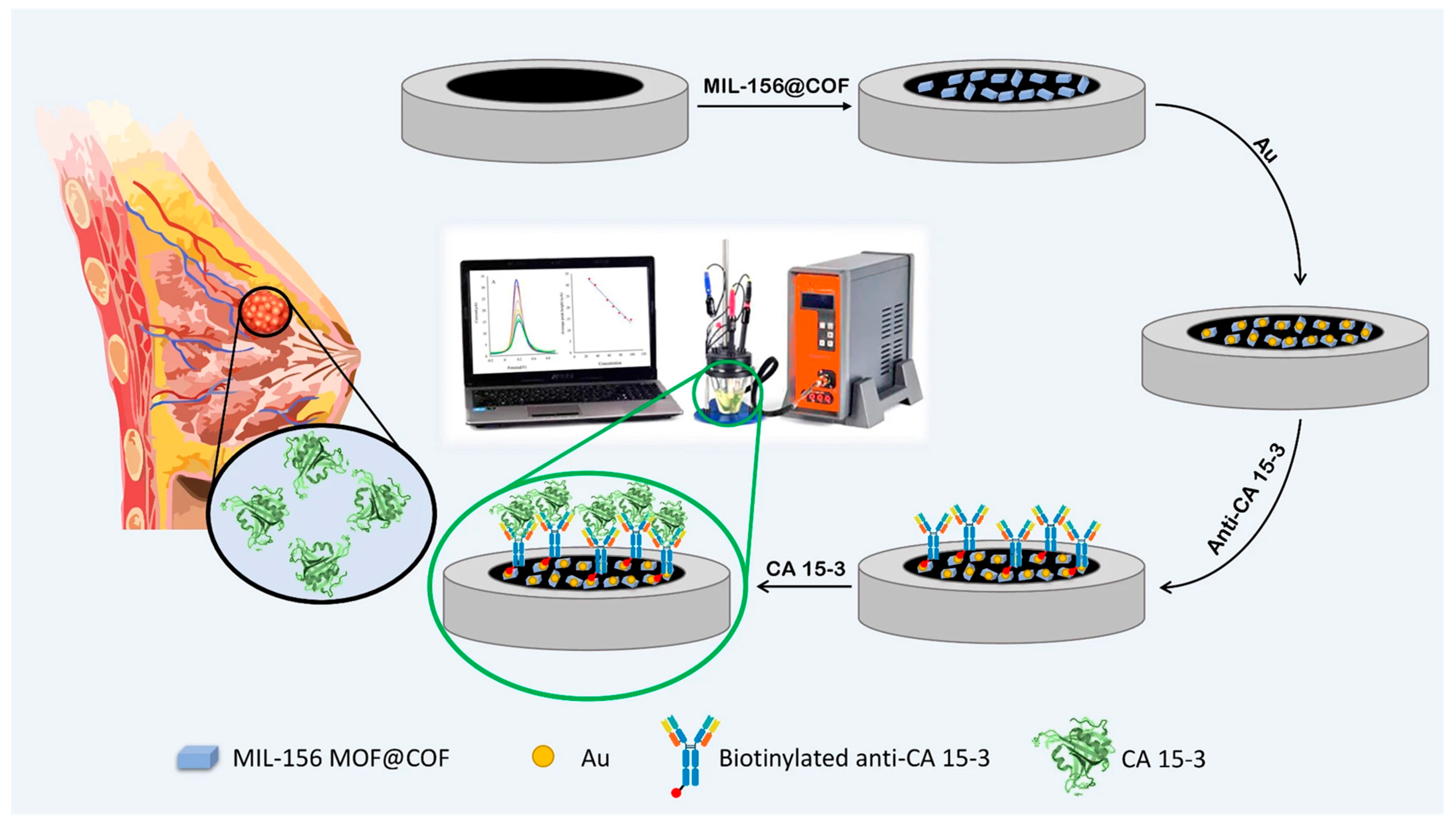
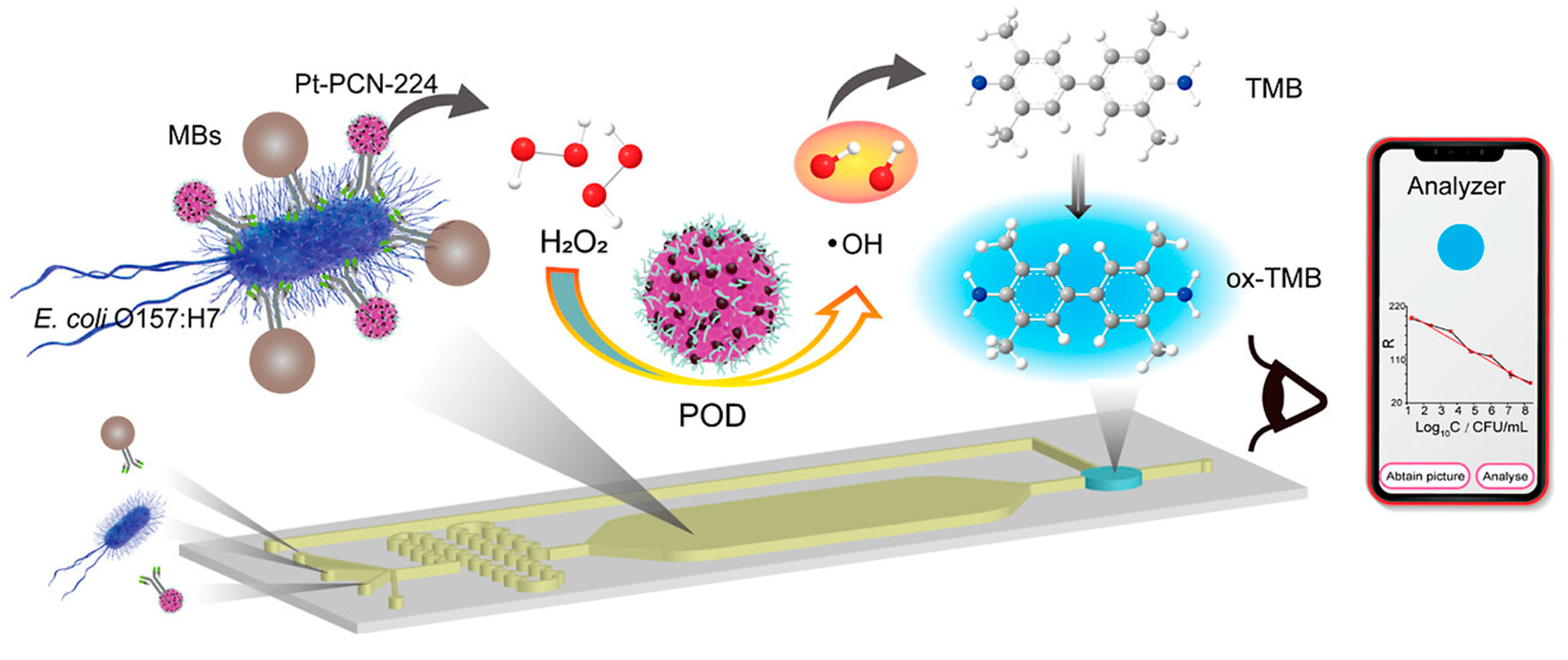
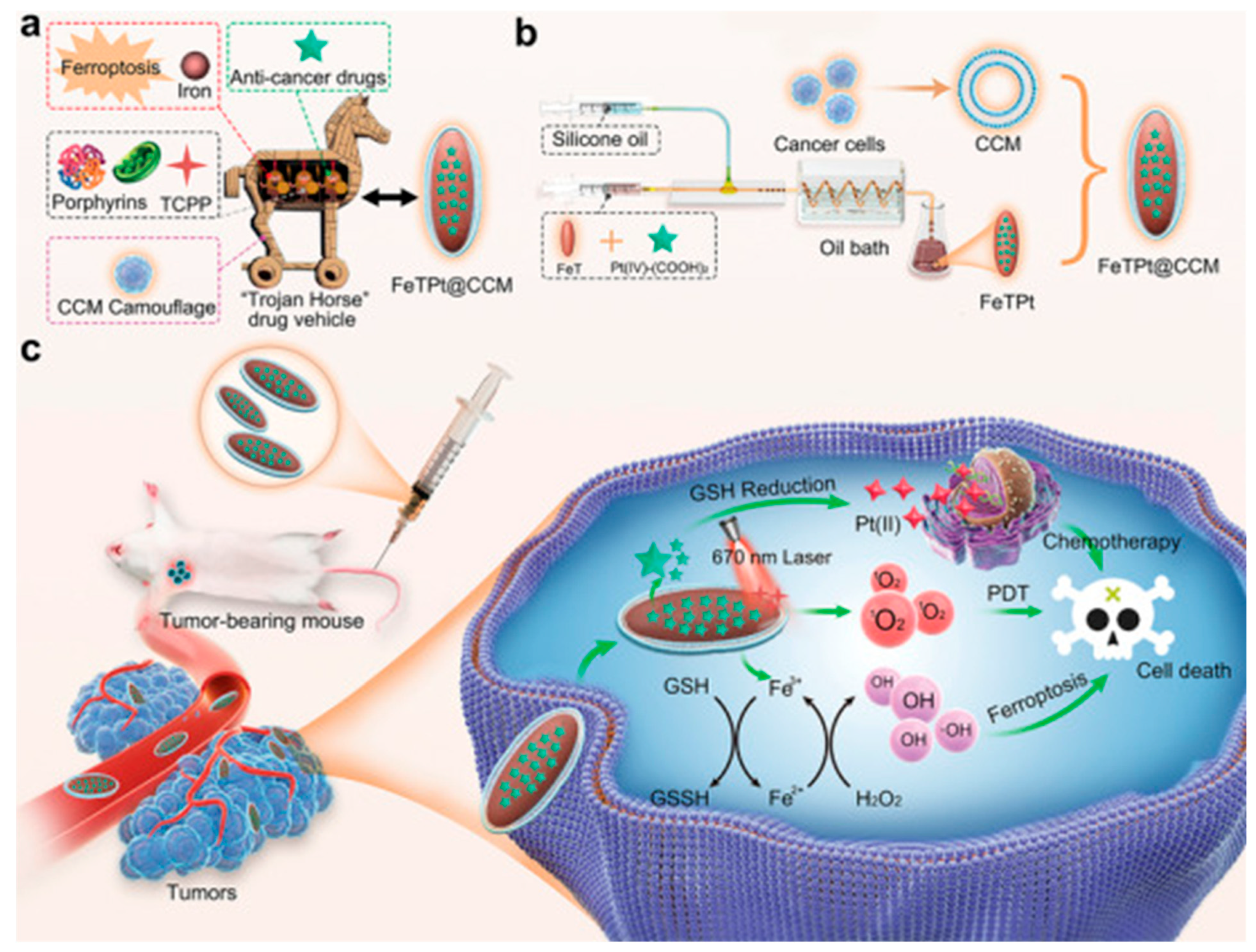
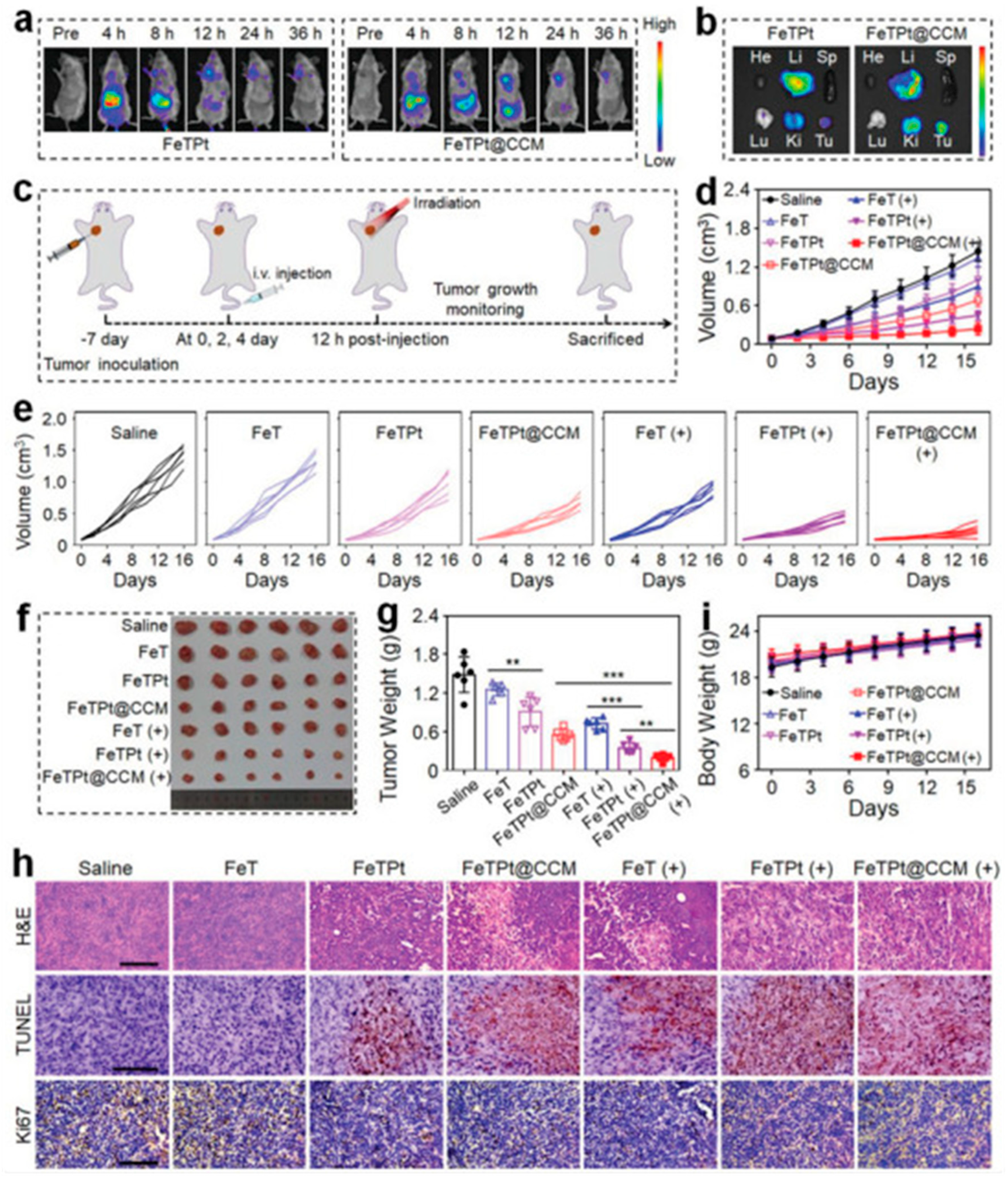
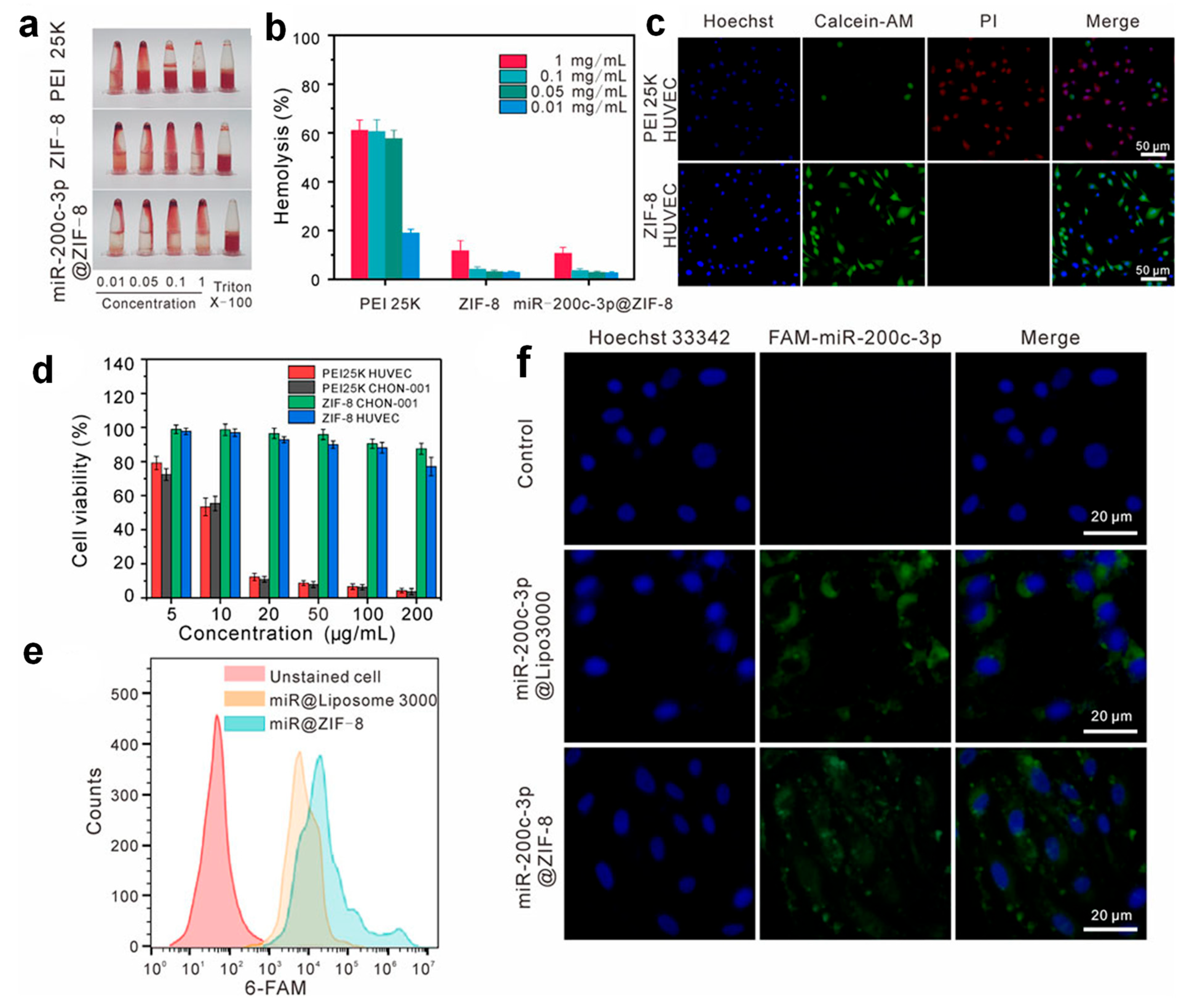
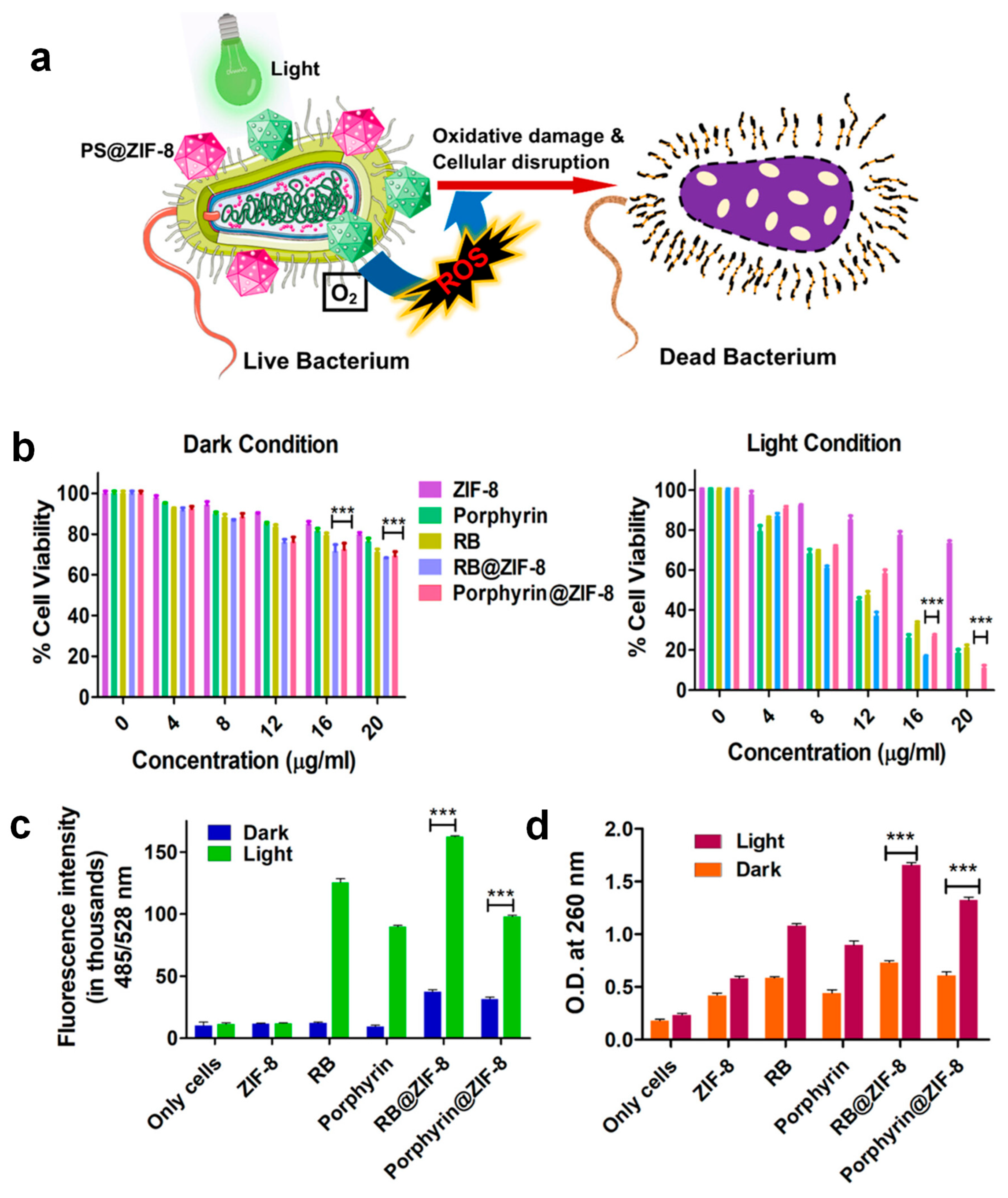
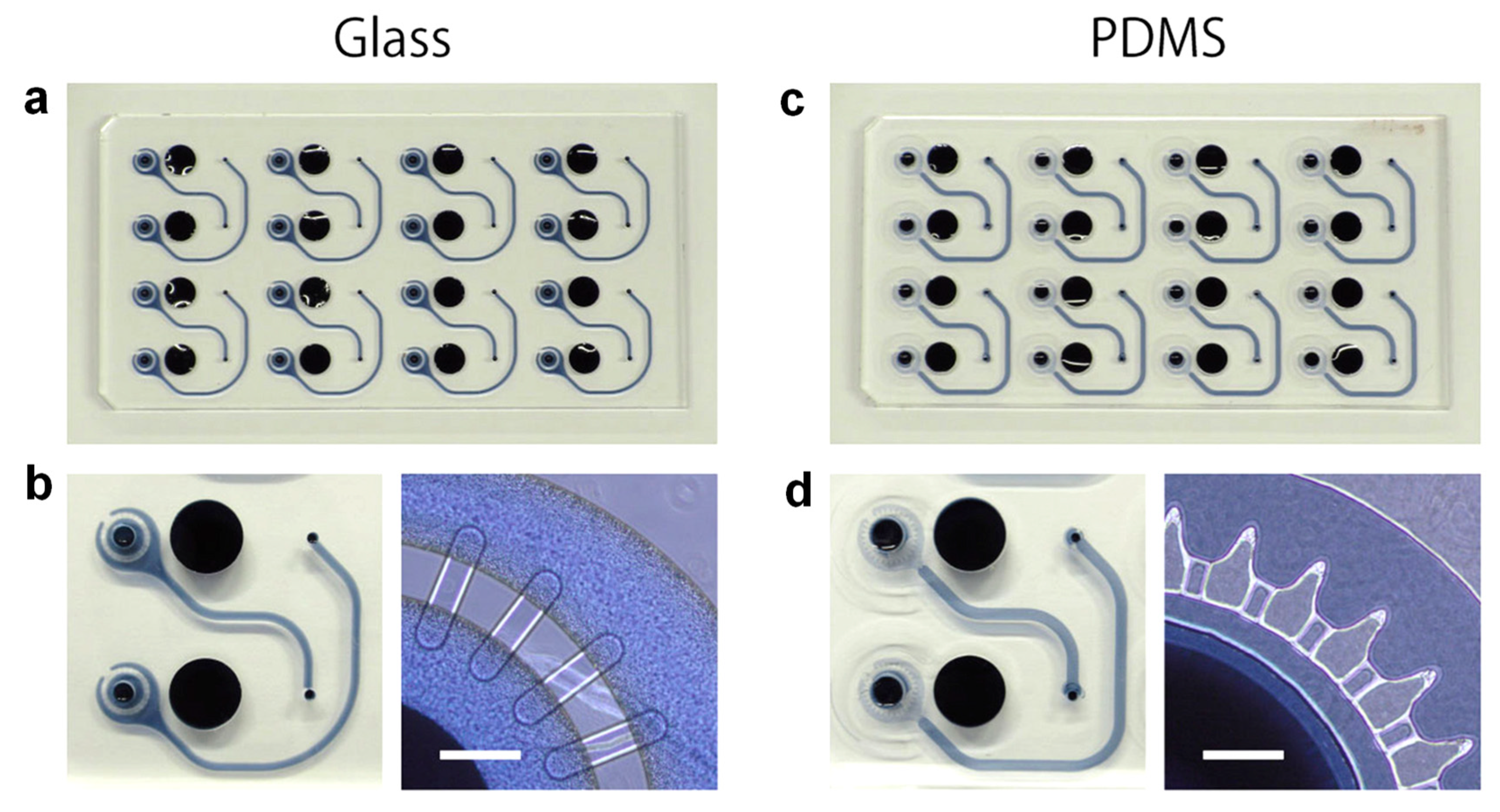
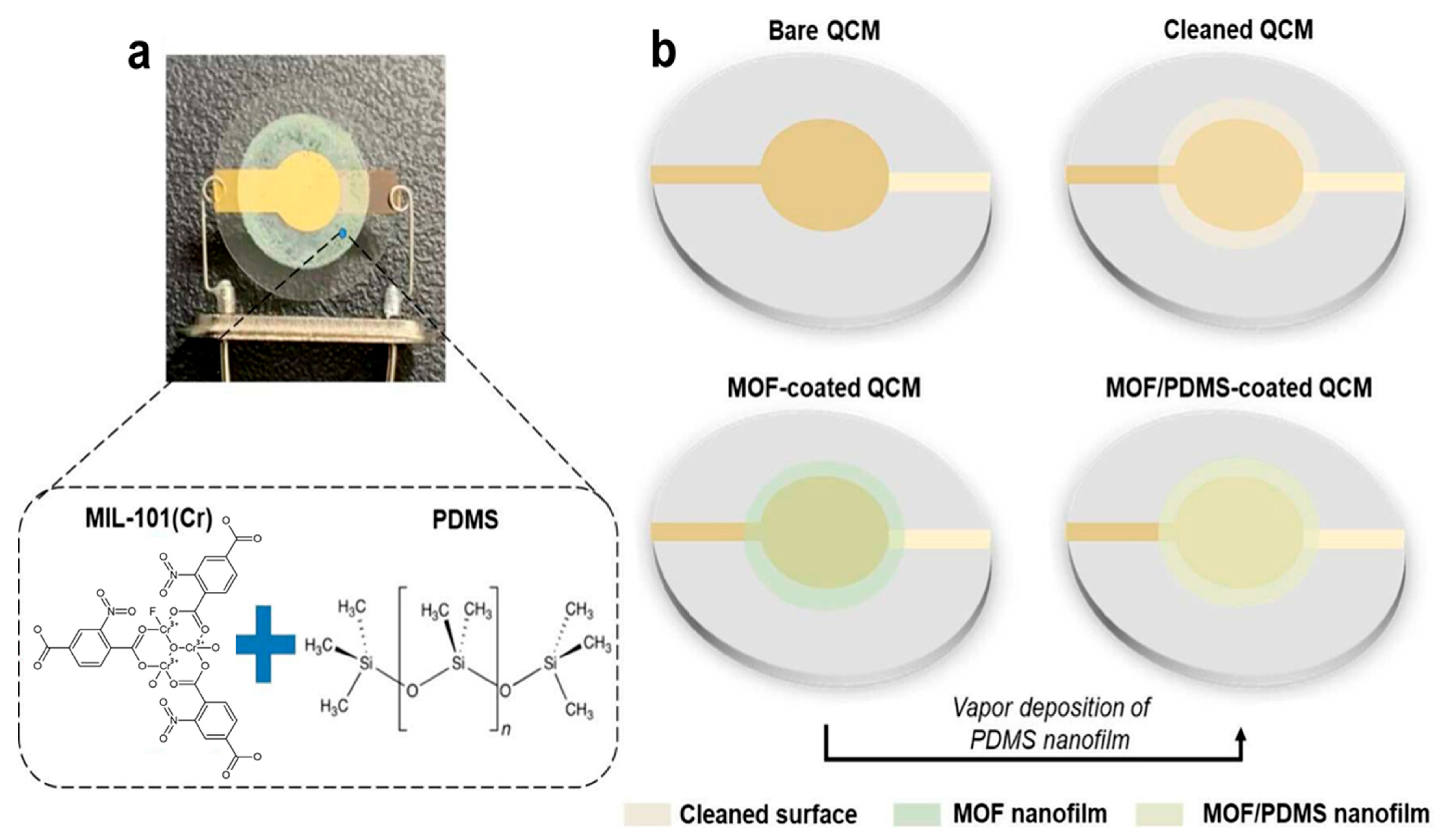
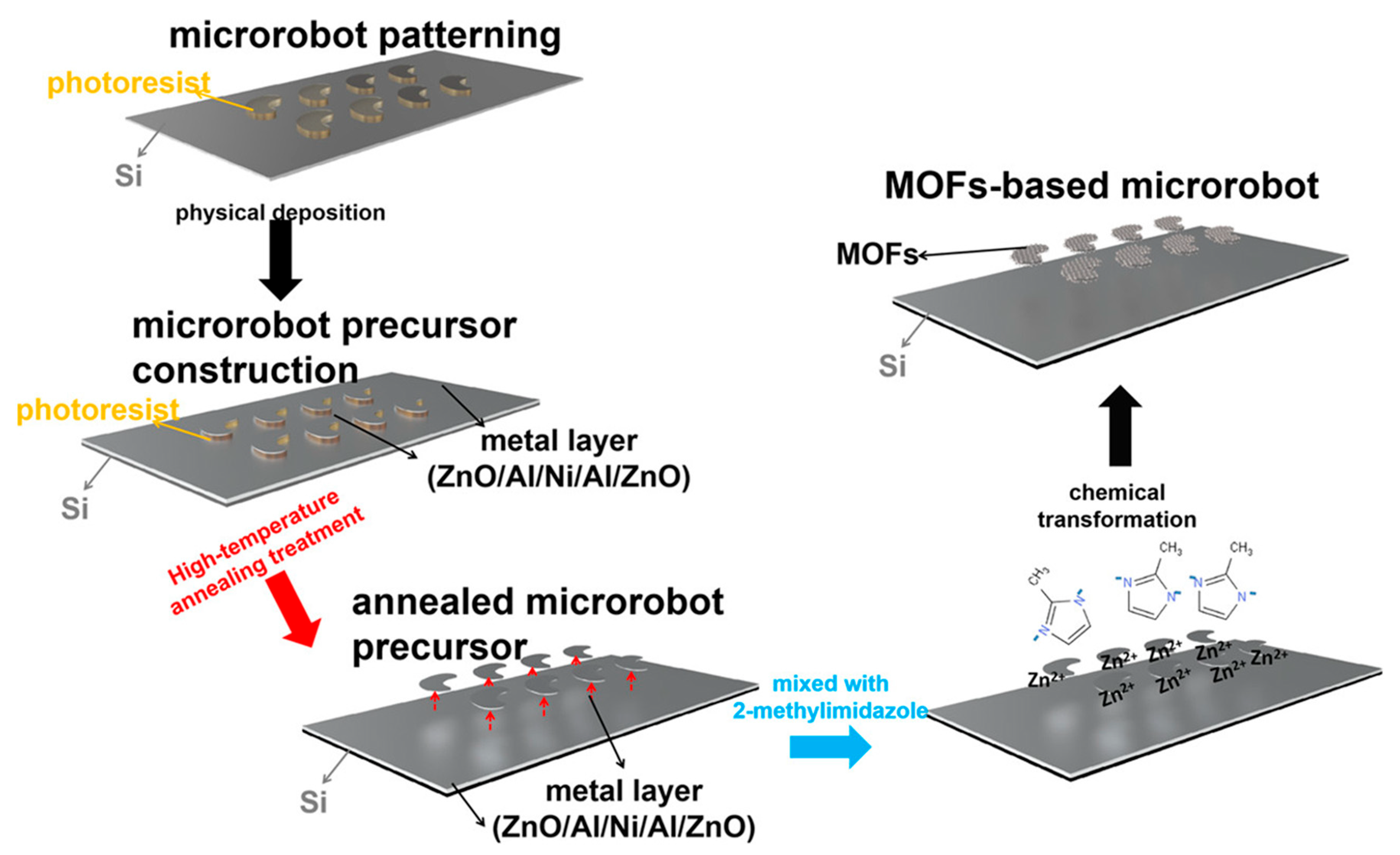

Disclaimer/Publisher’s Note: The statements, opinions and data contained in all publications are solely those of the individual author(s) and contributor(s) and not of MDPI and/or the editor(s). MDPI and/or the editor(s) disclaim responsibility for any injury to people or property resulting from any ideas, methods, instructions or products referred to in the content. |
© 2025 by the authors. Licensee MDPI, Basel, Switzerland. This article is an open access article distributed under the terms and conditions of the Creative Commons Attribution (CC BY) license (https://creativecommons.org/licenses/by/4.0/).
Share and Cite
Kidanemariam, A.; Cho, S. Recent Advancements in Metal–Organic Framework-Based Microfluidic Chips for Biomedical Applications. Micromachines 2025, 16, 736. https://doi.org/10.3390/mi16070736
Kidanemariam A, Cho S. Recent Advancements in Metal–Organic Framework-Based Microfluidic Chips for Biomedical Applications. Micromachines. 2025; 16(7):736. https://doi.org/10.3390/mi16070736
Chicago/Turabian StyleKidanemariam, Alemayehu, and Sungbo Cho. 2025. "Recent Advancements in Metal–Organic Framework-Based Microfluidic Chips for Biomedical Applications" Micromachines 16, no. 7: 736. https://doi.org/10.3390/mi16070736
APA StyleKidanemariam, A., & Cho, S. (2025). Recent Advancements in Metal–Organic Framework-Based Microfluidic Chips for Biomedical Applications. Micromachines, 16(7), 736. https://doi.org/10.3390/mi16070736







